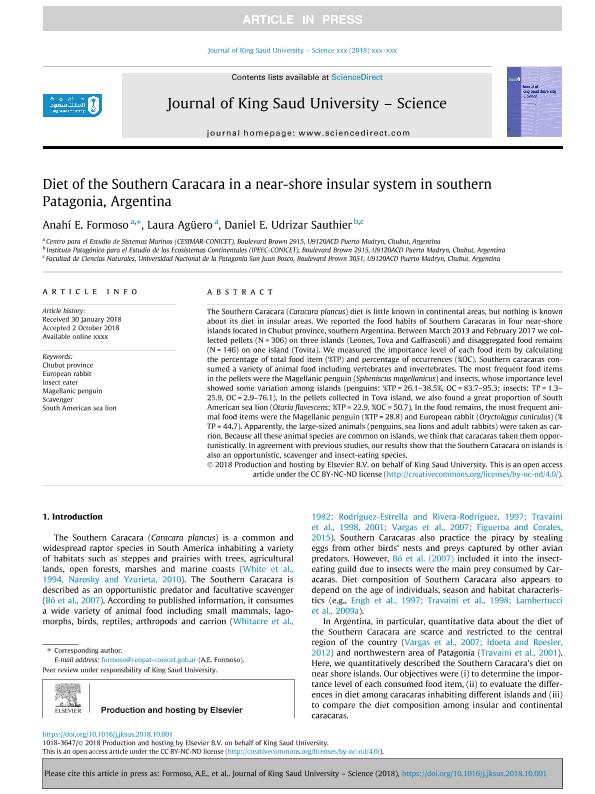Mostrar el registro sencillo del ítem
dc.contributor.author
Formoso, Anahí Elizabeth

dc.contributor.author
Agüero, Maria Laura

dc.contributor.author
Udrizar Sauthier, Daniel Edgardo

dc.date.available
2019-11-14T18:30:39Z
dc.date.issued
2018-10
dc.identifier.citation
Formoso, Anahí Elizabeth; Agüero, Maria Laura; Udrizar Sauthier, Daniel Edgardo; Diet of the Southern Caracara in a near-shore insular system in southern Patagonia, Argentina; Elsevier Science; Journal of King Saud University - Science; 10-2018; 1-5
dc.identifier.issn
1018-3647
dc.identifier.uri
http://hdl.handle.net/11336/88920
dc.description.abstract
The Southern Caracara (Caracara plancus) diet is little known in continental areas, but nothing is known about its diet in insular areas. We reported the food habits of Southern Caracaras in four near-shore islands located in Chubut province, southern Argentina. Between March 2013 and February 2017 we collected pellets (N = 306) on three islands (Leones, Tova and Galfrascoli) and disaggregated food remains (N = 146) on one island (Tovita). We measured the importance level of each food item by calculating the percentage of total food item (%TP) and percentage of occurrences (%OC). Southern caracaras consumed a variety of animal food including vertebrates and invertebrates. The most frequent food items in the pellets were the Magellanic penguin (Spheniscus magellanicus) and insects, whose importance level showed some variation among islands (penguins: %TP = 26.1–38.5%, OC = 83.7–95.3; insects: TP = 1.3–25.9, OC = 2.9–76.1). In the pellets collected in Tova island, we also found a great proportion of South American sea lion (Otaria flavescens; %TP = 22.9, %OC = 50.7). In the food remains, the most frequent animal food items were the Magellanic penguin (%TP = 28.8) and European rabbit (Oryctolagus cuniculus) (%TP = 44.7). Apparently, the large-sized animals (penguins, sea lions and adult rabbits) were taken as carrion. Because all these animal species are common on islands, we think that caracaras taken them opportunistically. In agreement with previous studies, our results show that the Southern Caracara on islands is also an opportunistic, scavenger and insect-eating species.
dc.format
application/pdf
dc.language.iso
eng
dc.publisher
Elsevier Science

dc.rights
info:eu-repo/semantics/openAccess
dc.rights.uri
https://creativecommons.org/licenses/by-nc-nd/2.5/ar/
dc.subject
CHUBUT PROVINCE
dc.subject
EUROPEAN RABBIT
dc.subject
INSECT EATER
dc.subject
MAGELLANIC PENGUIN
dc.subject
SCAVENGER
dc.subject
SOUTH AMERICAN SEA LION
dc.subject.classification
Ecología

dc.subject.classification
Ciencias Biológicas

dc.subject.classification
CIENCIAS NATURALES Y EXACTAS

dc.title
Diet of the Southern Caracara in a near-shore insular system in southern Patagonia, Argentina
dc.type
info:eu-repo/semantics/article
dc.type
info:ar-repo/semantics/artículo
dc.type
info:eu-repo/semantics/publishedVersion
dc.date.updated
2019-10-22T15:40:43Z
dc.journal.pagination
1-5
dc.journal.pais
Arabia Saudita

dc.description.fil
Fil: Formoso, Anahí Elizabeth. Consejo Nacional de Investigaciones Científicas y Técnicas. Centro Científico Tecnológico Conicet - Centro Nacional Patagónico. Centro para el Estudio de Sistemas Marinos; Argentina
dc.description.fil
Fil: Agüero, Maria Laura. Consejo Nacional de Investigaciones Científicas y Técnicas. Centro Científico Tecnológico Conicet - Centro Nacional Patagónico. Centro para el Estudio de Sistemas Marinos; Argentina
dc.description.fil
Fil: Udrizar Sauthier, Daniel Edgardo. Consejo Nacional de Investigaciones Científicas y Técnicas; Argentina. Universidad Nacional de la Patagonia "San Juan Bosco"; Argentina
dc.journal.title
Journal of King Saud University - Science
dc.relation.alternativeid
info:eu-repo/semantics/altIdentifier/doi/http://dx.doi.org/10.1016/j.jksus.2018.10.001
dc.relation.alternativeid
info:eu-repo/semantics/altIdentifier/url/https://www.sciencedirect.com/science/article/pii/S1018364718301551
Archivos asociados
